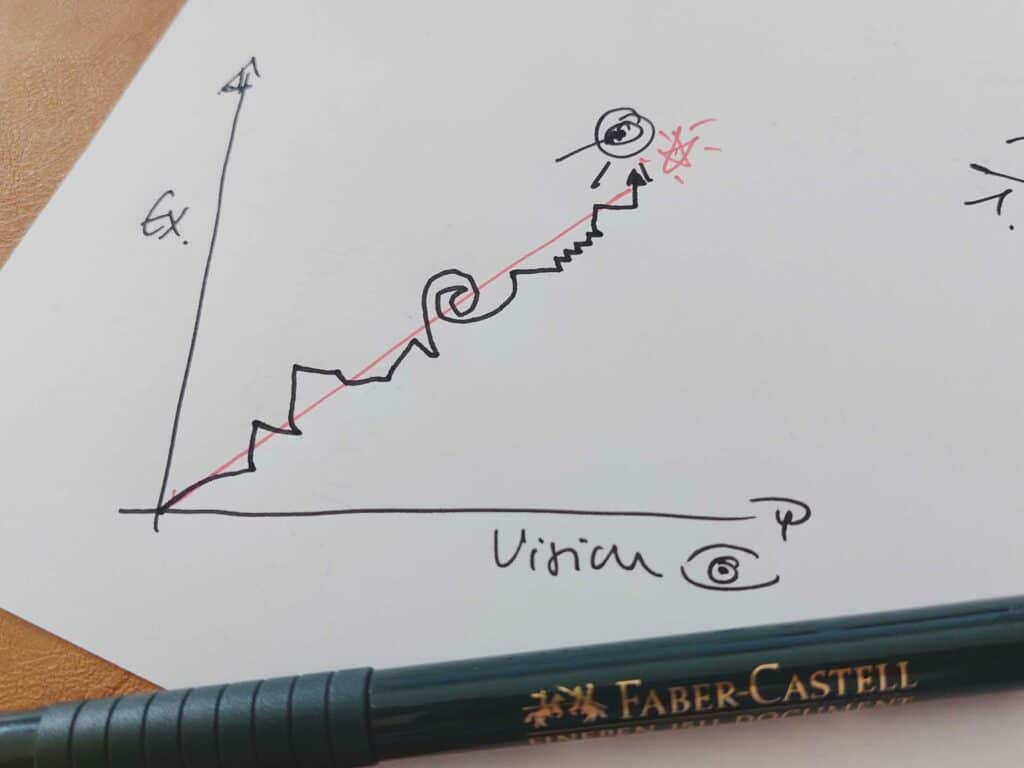The Challenging Balance of Vision vs. Execution: Our Best Hack for Startups + Scaleups
At OVERW8, we work workshop based with our clients most of the time. The participants will be the leadership team or parts of it, and in most cases, we start by reviewing the base of their brand before we head on to refine any details. To lay a solid ground, the vision of the company and/or the business model, in most cases, need a detailed look – so lots of strategy and big picture work going on.
Be honest: Were you already yawning when you’ve just read ‘strategy’?
You are not alone. It feels and can be really foggy, “does that get us anywhere” etc.
Startups and scaleups as we all know are (and should be) not the ones to fiddle around with strategy for months. We get it: You need to get stuff done.
Therefore, here at OVERW8, we have been experimenting with lots of different tools and approaches (did you know part of my background is in consulting and facilitation?), till we’ve found one that has proven to be most effective as it is
- pretty easy to understand,
- very hands-on in the application and
- you can easily decide how straight-forward vs. sophisticated you want it to be for your individual situation.
You probably will even have heard about it – though not in the context of using it in startup/scaleup strategy work.
In a way, it is a true hack because it uses what is already there in a very hands-on way – regarding the tool and whatever know-how is available in the team.
It is… the Gartner’s Magic Quadrant.
Initially, the Gartner Magic Quadrant was not even intended to be a workshop tool; it is much rather a research concept developed by the Gartner Group. As so often with genuinely great tools, its brilliance stems from its simplicity.
The Gartner Magic Quadrant uses these two dimensions:
- Completeness of Vision
- Ability to Execute
From my point of view, the results will show who is the category leader in any given market.
For Zoom and its market, it will look like this:
As one can see here, Webex/Cisco, Microsoft (Teams) and Zoom are the leaders in the field.
One can now discuss whether Microsoft indeed shows less completeness of vision and more execution power – it is not a mathematical tool in that sense, but more importantly, a good trigger for productive argumentation: If I claim Zoom has the higher ability to execute – what is my reasoning for it?
You might say: Well, this concept is mainly applied to the ‘big’ names so far – why should we transfer this way of thinking over to the startup and scaleup world?
Because being the leader in your field pays – no matter what growth stage you’re in.
Our clients and we just love using it in our kick-off workshops.
Being or becoming the so-called “category leader” in any given market has considerable advantages:
- you are the one setting the standards and quality levels
- this can and should go so far as to shape the expectations of the users and clients (so if they love your product, they will compare the competitor’s offerings versus yours)
- you will probably have the biggest purchasing power
- get lots of learning curve effects in more quickly if you allow for that
- your company value will most probably reflect the position in the market sooner or later
It is important to note that this point of view will provide the best insights if your company aims for a quality positioning. That is also why it links in so nicely with building a brand, creating customer value and company value as a mid-to-long-term result.
So, even if your company is not listed on the stock market yet or never intends to be, aiming for the upper right corner of the Gartner Magic Quadrant is a good ambition.
Next, let us look at how robust the setup of the two dimensions is – will they hold up? Plus, I will share three very effective use cases for implementing the Gartner Magic Quadrant in your work process.
Let us do a counter-check – what happens if only one dimension works for a company?
A) If only “Completeness of Vision” applies:
This can look pretty cool at first – but basically, a brilliant idea without quality execution will not transform into clients, sold goods, or turnover.
B) If only “Ability to Execute” applies:
In this case, the actions might be pretty effective, with great follow-through to the last detail – but which detail precisely if you are missing out on the bigger vision?
It might even get you to a certain level. Especially in a strongly led mid-size company, this might work for some time as the owner – even if he/she does not communicate it clearly – will have a vision and shape the decision-making for its execution.
However, it will prevent serious scalability and, therefore, a certain grandezza (zero grandezza = zero investors).
Use Case A: Shape the Vision and the Path to Execution
So what we normally need to work on first is the “completeness of vision”.
This is not as simple as it sounds as also, on this level, it has to strike a balance between
- being big enough so there is enough attraction to get up in the morning for it. Also,
- it needs to stay at least on the edge of feasibility so one does not already feel overstretched just by looking at it.
In most cases, in the founder’s brains, there already exist quite a lot of details about the vision – and what we (roughly speaking) then do is
- to get them to talk about it,
- facilitate to help them find alignment and lastly but not least
- support with transforming it into a written down version.
That can already make all the difference as it helps cut off the foggy areas, providing much more clarity for the team on what to shoot for.
This version might be the first to be adapted and shaped again later, but it is a much better place to start. People (including investors) will be able to sense that clarity and trust you more (with good reason).
In the second work phase, the focus will shift to the “ability to execute” – for some time.
We need to ensure that branding, marketing, and sales-wise, all the elements needed for execution are created and then implemented.
This might sound pretty straightforward.
In reality, having a new brand positioning and manual will not do the trick.
It is all about transferring it into every everyday task that is related to clients one by one.
It is easy to get distracted or totally off track.
What to do in that case?
Check in again with the main documentation (that is why that makes so much sense to put it down in written form) on the big-picture/vision level and then refine the execution from there.
Use Case B: Use the Magic Quadrant for a Simple Competitors’ Review
Truly innovative startups might indeed shape a market that before did not exist – think SAP andB2B software in the 90ies. Therefore, according to our experience in working with startup and scaleup situations, classic competitor overviews are often not as helpful.
Our alternative recommendation:
Use one or several of these quadrants to map out your competitors vs. your own company.
Be sure to record the well-researched base of your assumptions (it will not get you any insight if you decide to turn a blind eye to what your competitors are doing in contrast vs. the massively cool triggers for areas to optimize or focus on you could find like that).
Depending on the concreteness level of the industry/solution you are creating, it will be clever to create one Magic Quadrant for each adjoining market and then even layer them to detect patterns.
You will have a much better base for discussing and identifying leverage activities through this.
Plus (pro tip): It can be an excellent chart to add to your pitch deck, impressing your future investors with lots of big-picture overview.
Use Case C: Review Direction and Focus
This is another reason why we think the quadrant is so very practical:
The Gartner Magic Quadrant helps define whether we develop towards the right direction – and what to focus on next.
In a big corporation, there might and should be resources to drive both dimensions simultaneously.
In a startup/scaleup situation, resources will probably still be a bit restricted. Do not be surprised and allow yourself to switch between the modes creating more of a staircase-like development path.

It then helps allocate focus and resources:
- If a lot has been reached on the execution dimension, chances are it is good to check in with the vision.
- If on a big-picture level, a lot has been shaped, chances are it is necessary to focus a bit more on execution again.
So here you go with an insight into a valuable tool we use when working with our startup/scaleup clients.
As you can see, we can get pretty out of the box when looking for something that just works.
Because that is the one main criterion in the startup/scaleup world, isn’t it?
Finding stuff that just works.
Let us know what works for you:
- Have you ever worked with the Magic Quadrant yourself? If so: What’s your insight here?
- Have you ever used a tool differently than it was intended in the first place? What was it – and how did it work out?
- Which tools or methods do you love most to shape strategy and the big picture – and turn it into action?











Leave a Reply